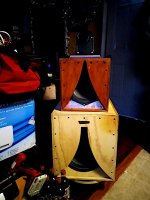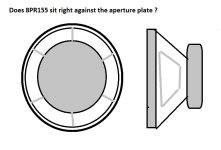Taking into account last developments in loudspeaker`s controlling DSP, the idea to build a loudspeaker with next quality level was borne. It is well known idea to use multi way concept to meet requirements for sound reproduction/radiation of particular frequency band with physical properties of particular driver/loudspeaker unit and to eliminate cross impact of different frequencies , known as the intermodulation.
But what about extreme multi way with so narrow bandwidth of ways that we can use bandpass enclosure almost for all ways. Which increases sensitivity/gain of particular driver and is doing a filtering of out of band components, nonlinear distortion harmonics, as well. Exactly same way as singers are using natural resonators to excite as with a pleasant musical performance.
Here it is. Please meat a 5 way loudspeaker with first 3 ways in bandpasses







But what about extreme multi way with so narrow bandwidth of ways that we can use bandpass enclosure almost for all ways. Which increases sensitivity/gain of particular driver and is doing a filtering of out of band components, nonlinear distortion harmonics, as well. Exactly same way as singers are using natural resonators to excite as with a pleasant musical performance.
Here it is. Please meat a 5 way loudspeaker with first 3 ways in bandpasses
its quite striking to see its build quality. Regarding the circular aperture and assuming "one" cone driver - is the center piece a phase plug which protrudes into the cone? - or more of a cavity in front of the cone? What size/model of driver is employed and how much volume is in its "front chamber"?
What are the ranges for each section? Can the technique be used with simpler - less ambitious builds and passive crossovers to good effect?
Here's my toy
What are the ranges for each section? Can the technique be used with simpler - less ambitious builds and passive crossovers to good effect?
Here's my toy
Attachments
My kind of design! Played around awhile back and found that if all the drivers adhered to the pioneer's simple design it could work really well with made up drivers, so might be too much tweaking using in stock drivers:
HR's BP4
Vc1 = Vc2/4
Vc2 = Vas/1.44
Ap1 = Sd/3
Fb = Fs/0.707
HR's BP4
Vc1 = Vc2/4
Vc2 = Vas/1.44
Ap1 = Sd/3
Fb = Fs/0.707
@wolf_teeth - Did not see any problems with impedance - clearly active system
Drivers are:
15` faital 15FH530
8` faital 8PR155
5` faital M5N8-80
daytonaudio PHT1-6
daytonaudio AMT Mini8
Crossover frequencies: 120, 500, 2.5k, 12k
@freddi Can the technique be used with simpler - less ambitious builds and passive crossovers to good effect? - I think no. An active crossover, nowadays, is simpler and cheaper then a passive one. And how will you take under control such banpasses as you will see below?








It is for 3d way, 5 inch driver behind it.Tenson said:What is the vent below the tweeter?
Drivers are:
15` faital 15FH530
8` faital 8PR155
5` faital M5N8-80
daytonaudio PHT1-6
daytonaudio AMT Mini8
Crossover frequencies: 120, 500, 2.5k, 12k
@freddi Can the technique be used with simpler - less ambitious builds and passive crossovers to good effect? - I think no. An active crossover, nowadays, is simpler and cheaper then a passive one. And how will you take under control such banpasses as you will see below?
Here you are!Show us the measurements...
I see - if one is using commercial already made amplifiers then a dedicated DSP unit is in order.
quite a set of (interesting) measurements - your 8" Faital is pretty much like my 8pl21 BC.
(With a Karlsonesque stack - I think some cavity peaking could be nulled with a damped stub at the top of the front chamber and a passive network can work)
How do you like and perceive the result vs using direct radiating mode with similar driver complement ? How does 8PR155 work directivity wise with its aperture? Can the woofer section out-punch its direct radiator cousin when called upon with appropriate program material?
This is the most interesting system I've seen in a long time.
quite a set of (interesting) measurements - your 8" Faital is pretty much like my 8pl21 BC.
(With a Karlsonesque stack - I think some cavity peaking could be nulled with a damped stub at the top of the front chamber and a passive network can work)
How do you like and perceive the result vs using direct radiating mode with similar driver complement ? How does 8PR155 work directivity wise with its aperture? Can the woofer section out-punch its direct radiator cousin when called upon with appropriate program material?
This is the most interesting system I've seen in a long time.
9/4 = ~2.25 LGM - so pioneer BC 8pe21 BP4 ` 9 liter rear chamber (Vas = 13l) 73 cm2 diffraction slot port in front of ~3.2 liter front cavity
Thank you @freddi @Stuey
For me, as from live sound production, sound tracks with well recorded drum set is a test preference. Especially "It`s on" from George Duke`s "After Hours".
The "Whole drum set" from Parson`s test CD is very good as well.
Except tweeters have some kind of directivity.
On anther hand, the measurements of each way (see above) were Sound Power measurements taking into account directivity, but the final crossover tune was done from one point measurement and no additional tweaks was added for this one point measurement. I hope you will agree with me that accuracy is pretty much sufficient. I am relying to the Sound Power measurements for 20 years...
@xrk971 @Tenson Very impressive Raimonds! Is that a custom 5 channel DSP board you designed?
Thanks! Yes, it is actuality 10 channel unit (2 times 5 for stereo) with 4096 tap FIRs for each output and input channel.
And its implements such control that amplifiers can be 10 times more powerful then particular driver to play the music which is an "expencive" noise with Gaussian amplitude distribution (peeks 10 times more powerful then average) from engineering prospective .
My guests, when listening to this system, pointed to the fact that sound stage is far behind the loudspeakers. It means, the small sound details, that are creating the stage image, are not more masked by distortion products...How do you like and perceive the result vs using direct radiating mode with similar driver complement ?
For me, as from live sound production, sound tracks with well recorded drum set is a test preference. Especially "It`s on" from George Duke`s "After Hours".
The "Whole drum set" from Parson`s test CD is very good as well.
The design target was to exploit all the beauty of the bandpass - increased sensitivity reduces necessary electric power, which reduces distortions. And the banpass as acoustic filter is filtering out nonlinear distortion (harmonics) as well.Could you be a bit more specific about your design targets?
And could you elaborate about the advantages of bandpass loading in your specific case?
I am slightly lazy for that : ) But I set the design constrains such that each particular way should be as close as possible to the point source. I think I have met that.Its impressive on axis. I would love to see polar maps.
Except tweeters have some kind of directivity.
On anther hand, the measurements of each way (see above) were Sound Power measurements taking into account directivity, but the final crossover tune was done from one point measurement and no additional tweaks was added for this one point measurement. I hope you will agree with me that accuracy is pretty much sufficient. I am relying to the Sound Power measurements for 20 years...
They were not set as constrains or intentionally measured after. You can judge they about values from measurement curves above. But as they can not go out of the control of dsp there are no worries about that.What are the Qs in the respectively bandpass ways?
The front chamber is pretty much large. I will add some "naked" pictures to see that.does 8PR155's front gasket rest directly upon its aperture plate? - or is there a gap to create more front chamber?
@xrk971 @Tenson Very impressive Raimonds! Is that a custom 5 channel DSP board you designed?
Thanks! Yes, it is actuality 10 channel unit (2 times 5 for stereo) with 4096 tap FIRs for each output and input channel.
And its implements such control that amplifiers can be 10 times more powerful then particular driver to play the music which is an "expencive" noise with Gaussian amplitude distribution (peeks 10 times more powerful then average) from engineering prospective .
You are very very close : )9/4 = ~2.25 L
Sorry : ) It wasn't meant to be ... But questions are questions and require answersNow you're just showing off!
- Home
- Loudspeakers
- Multi-Way
- The making of the singing loudspeakers

